| |
WOODPECKERS Picidae |
- 216 species worldwide (except Australasia)
- DR personal total: 116 species (54%), 31 photo'd
|
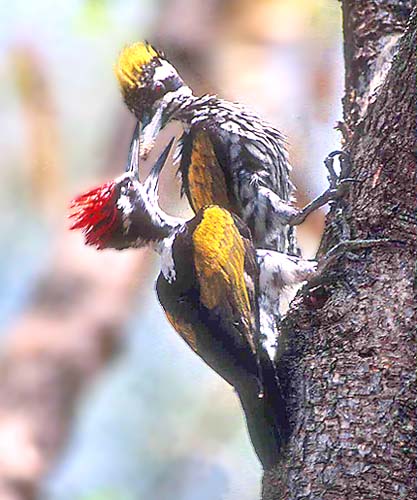 Woodpeckers are simply impressive birds. I am pleased whenever I can
photograph one. I felt particularly lucky to photograph this pair of White-naped Woodpecker
in India (left). But these were not a "pair" in the traditional sense —
the yellow-crowned female was feeding the red-crowned bird. I think the
red-crowned one was her now full-grown fledgling. She had been working
a long time to get out the thick grub, and the shot was taken just
before she shoved the big grub down the youngster's gullet.
Woodpeckers are simply impressive birds. I am pleased whenever I can
photograph one. I felt particularly lucky to photograph this pair of White-naped Woodpecker
in India (left). But these were not a "pair" in the traditional sense —
the yellow-crowned female was feeding the red-crowned bird. I think the
red-crowned one was her now full-grown fledgling. She had been working
a long time to get out the thick grub, and the shot was taken just
before she shoved the big grub down the youngster's gullet.
I felt even luckier when Handbook of the Birds of the World chose to publish this photo. Yet, although my cover letter described the circumstances, the eventual HBW
text read: "Courtship displays of woodpeckers feature many elements
that are used when showing aggression. The crown feathers are erected,
the head raised and the wings drooped. Mate-feeding has been observed
as part of the courtship ritual of only a few picid species, among them
two Dinopium and two Melanerpes, but has only rarely
been reported for the White-naped Woodpecker. Here, the red-crowned
male of the latter has just presented his yellow-crowned mate with a
beetle larva" (Vol. 7 at p. 376).
Well, er, no. That's not what happened. But it's a nice photo anyway. |
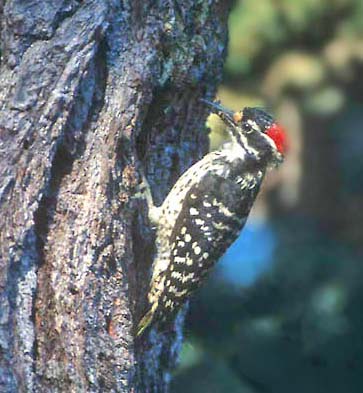 Woodpeckers
are a large family of similarly designed birds found in forested areas
around the globe. They have evolved to deal with chiseling wood,
including "shock-absorber" head musculature, extremely long tongues,
and stiff tail feathers helping them perch upright on trees (Winkler
& Christie 2002). Woodpeckers are often a "core species" of the
woodland avifauna [except in two major areas that don't have any
woodpeckers: Australasia and Madagascar]. I am very fond of the
woodpeckers that live in my yard on the Monterey Peninsula. This male Nuttall's Woodpecker
(right) was bringing food to nest hole just outside our bedroom window
in June 2002. We had left a tall stub of this dead Monterey pine when
we had to remove the top-heavy canopy for safety reasons, and the next
year we were rewarded with a pair of Nuttall's that fledged a
youngster. The tree stub would eventually crumble in high winter winds
a few years later, but "our" family of these attractive little
woodpeckers still frequents the neighborhood. Hairy Woodpecker Picoides villosus also nests occasionally in the yard, as do a small party of Acorn Woodpeckers. Woodpeckers
are a large family of similarly designed birds found in forested areas
around the globe. They have evolved to deal with chiseling wood,
including "shock-absorber" head musculature, extremely long tongues,
and stiff tail feathers helping them perch upright on trees (Winkler
& Christie 2002). Woodpeckers are often a "core species" of the
woodland avifauna [except in two major areas that don't have any
woodpeckers: Australasia and Madagascar]. I am very fond of the
woodpeckers that live in my yard on the Monterey Peninsula. This male Nuttall's Woodpecker
(right) was bringing food to nest hole just outside our bedroom window
in June 2002. We had left a tall stub of this dead Monterey pine when
we had to remove the top-heavy canopy for safety reasons, and the next
year we were rewarded with a pair of Nuttall's that fledged a
youngster. The tree stub would eventually crumble in high winter winds
a few years later, but "our" family of these attractive little
woodpeckers still frequents the neighborhood. Hairy Woodpecker Picoides villosus also nests occasionally in the yard, as do a small party of Acorn Woodpeckers.
Acorn Woodpecker
breeds cooperatively in communal groups featuring one or two lead
males, a harem of females (mostly sisters), and youngsters from the
previous year, one of the most unusual breeding systems in the natural
world. Much of the research has occurred in the oak woodlands of
Monterey County, California (where I live), and some fascinating facts
are in MacRoberts & MacRoberts (1976), Koenig (1981), Koenig &
Mumme (1987), and Stacey & Koenig (1984). Acorn Woodpeckers also
collect and store acorns in "granary trees" against lean times (below).
They are also frequent at my bird feeder, eating ordinary bird seed in
times when acorn crops are poor. |
|
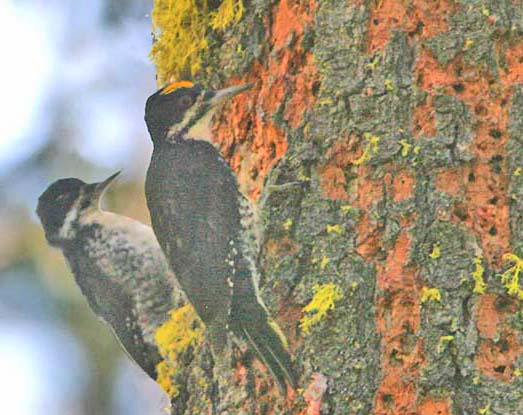 More
fine woodpeckers occur in the red fir/lodgepole pine forests of the
Sierra Nevada. There is almost nothing so pleasant on a lazy summer day
in the mountains as listening for the tapping of woodpeckers and
chasing each one down. The ultimate highlight is finding a rare Black-backed Woodpecker (left); this male was accompanied by a young fledgling. More
fine woodpeckers occur in the red fir/lodgepole pine forests of the
Sierra Nevada. There is almost nothing so pleasant on a lazy summer day
in the mountains as listening for the tapping of woodpeckers and
chasing each one down. The ultimate highlight is finding a rare Black-backed Woodpecker (left); this male was accompanied by a young fledgling.
Woodpeckers
come in a great variety of shapes and colors. Flickers specialize in
feeding on the ground, often focusing on ants. The Campo Flicker
(below) of southern South America is such a species. Even it has the
stiffly pointed specialized tail feathers that allow woodpeckers to
perch vertically on tree trunks. |
|
| Another
specialized group are the sapsuckers of North America. They drill small
holes into the cambium layer of living trees, causing sap to ooze forth
slowly. They do this on a set of favored (usually young) trees and then
follow their "trap line" from tree to tree, drinking the sap and
sometimes consuming insects attracted to it. Birch, aspen, willow and
orchard fruit trees are often favored, but they use some live oaks and
key into certain non-native trees (like pepper trees). In all, their
regular little square holes have been documented on over 250 species of
native trees. The juvenal-plumaged Yellow-breasted Sapsucker
(below left) is perched near an oft-drilled tree; this particular
individual was a rare vagrant to coastal California. In the summer, Red-breasted Sapsucker (below right) breeds in the mountains and humid coastal forests of northern California. |
|
Woodpeckers
are often termed "core species" because their presence is a fundamental
requirement to the existence of a wide range of other birds.
Woodpeckers drill new nest holes each year, and thus many old nest
cavities are available for a entire suite of hole-nesting species. Many
smaller species of North American swallow are dependent on woodpecker
holes, as are virtually all the small owls, various bluebirds, and a
huge array of small birds (wrens, chickadees) that use them
advantageously. Thus the nest hole drilled by a Gila Woodpecker
(above left), a small woodpecker of the American southwest, will be
reused by other birds. The nest holes of large species like the Northern Flicker (above right) are particularly important for cavity-nesting species in western North America, and especially Purple Martins.
|
|
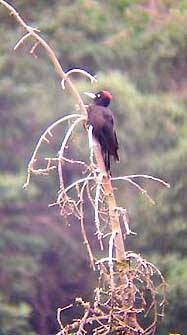 With
over two hundred species around the world, there is tremendous
diversity among the woodpeckers. The two wrynecks of the Old World are
included within the family, and there are well over two dozen species
of tiny piculets in the world's tropics. There are also huge
forest-dominating species in the several genera, including the genera Dryocopus and Campephilus. With
over two hundred species around the world, there is tremendous
diversity among the woodpeckers. The two wrynecks of the Old World are
included within the family, and there are well over two dozen species
of tiny piculets in the world's tropics. There are also huge
forest-dominating species in the several genera, including the genera Dryocopus and Campephilus.
These powerful birds, such as the two Mulleripicus from the Philippines (Sooty & Great Slaty Woodpeckers), are always prized by birders. A distant shot of Great Slaty Woodpecker is above, and one of Black Woodpecker
is to the right. My shots here are not much, but experiencing a huge
woodpecker deep in virgin jungle is always a memorable experience.
Among the huge woodpeckers nine species of extant Campephilus in the New World, and four (or more? the genus needs revisions) species of flameback (Dinopium) in southeast Asia.
Alas, two the world's most awesome woodpeckers have apparently become extinct within my lifetime. The Ivory-billed Woodpecker Campephilus principalis
of the southeastern U.S. and Cuba (which may have been a separate
species) was always scarce, but loss of sufficient tracts of wild
habitat doomed it by World War II. There have been widely reported
recent sightings, but no substantive evidence has yet convinced the
scientific community that the species is still extant. The Imperial
Woodpecker C. imperialis of virgin pine forests in the Sierra
Madre of nw. Mexico was even larger, and has not have been confirmed
since 1957. It appears these two great birds have been lost forever. |
| |
Photos: The presumed mother and child White-naped Woodpecker Chrysocolaptes festivus was at Tiger Moon Resort, Rajashan, India, on 26 Mar 2001. The Nuttall's Woodpecker Picoides nuttallii was feeding young at a nest hole in my backyard in Pacific Grove, California, on 5 June 2002. The acorn-storing Acorn Woodpecker Melanerpes formicivorus was in Monterey, California, on 8 Feb 2006. The adult male and young Black-backed Woodpecker Picoides arcticus were at Donner Pass, California, on 5 Aug 2006. The Campo Flicker Colaptes campestris was feeding on the ground in the Brazilian Pantanal in Aug 1999. The juvenal Yellow-bellied Sapsucker Sphyrapicus varius was a vagrant at Monterey, California, on 5 Jan 2007. The adult Red-breasted Sapsucker S. ruber was at Plaskett Meadows, California, on 18 June 2006. The female Gila Woodpecker Melanerpes uropygialis was at her nest hole in Brawley, Imperial Co., California, on 14 Apr 2005. The female Northern Flicker Colaptes auratus was coming out of her nest hole in Sacramento, California, in April 1980. The Great Slaty Woodpecker Mulleripicus pulverulentus was on Palawan I., the Philippines, in Dec 2005. The Black Woodpecker Dryocopus martius was at Huzu Beishan, Qinghai, China, on 23 June 2004. All photos © Don Roberson; all rights reserved.
Bibliographic note:
Family book: Rating 
Short, Lester. 1982. Woodpeckers of the World. Delaware Mus. Nat. Hist., Monogr. Ser. 4.
Family book: Rating 
Winkler, Hans, David A. Christie, and David Nurney. 1995. Woodpeckers: An Identification Guide to the Woodpeckers of the World. Houghton Mifflin, Boston, MA.
These two major family books represent their decades well. Short's 1982
was a true monograph, based heavily on his own research and incredibly
detailed in its discussion of behavior, vocalizations, and interactions
with other birds. It is a thick 676 pages. Color plates of all species
(by George Sandström) are bound together in back; there are no
range maps; details of distribution are set out at length in the text.
Taxonomy was one of Short's primary interests, so there is much here on
this topic.
The Winkler/Christie book (Nurney
was the artist) is a standard "cookie-cutter" family book, much like
the Pica Press series — although this one is by Houghton Mifflin, so
better in some ways — with color plates facing a short i.d. text bound
together in the front, and then detailed species accounts with range
maps. The introductory chapters are much shorter than in true
monographs, but at 406 pages this is a heftier effort than many other
family books in this format.
Neither has particularly outstanding art. In Short's tome several
species, sometimes from different continents, are shown together on a
single branch in a variety of positions; Nurney's art in the newer book
is "field guide" style, with all birds on each plate facing the same
way in the same posture. The latter layout is better for comparing
difficult species to each other, but neither format strikes any
evocative note, and I knock off one star from each book for
underwhelming art.
The differences in decades is apparent in the number of species
covered, although the exact same set of birds is at issue. Short,
writing at a time when "lumpers" were in the ascendancy, lists 198
species. Winkler/Christie list 214 species and, as one would expect,
spent some time talking about the new taxonomic proposals of Sibley
& Ahlquist (1990).
One wants a family book to have an outstanding bibliography for the
group, and the Winkler/Christie effort looks better in this regard. Of
course, they cite "Short (1982)" as the primary, seminal source for
much of their work. One must consult the Short book for any questions
of taxonomy (Winkler/Christie follow Short closely on subspecies
decisions), and for any question of vocalization or behavior. The clear
range maps in Winkler/Christie even up their deficiencies on Short's
strong topics. It does appear to me that Short will be more
authoritative on New World topics (he is an American and knows North
American woodpeckers particularly well), while Winkler/Christie are
comparatively weak on New World species (I think all the authors and
the artist are British), but presumably would be stronger on Old World
topics, particularly those in the Western Palearctic.
A disappointment in both books is their failure to address the finer
points of identification. Neither gets much beyond the "field guide"
stage of i.d., although Short is very strong on subspecific variation.
For example, here in Monterey County we occasional get claims by
visiting birders of a male "Black-backed Woodpecker" in our mountains.
Such a claim is presumed erroneous, and certainly all those from the
summer are wrong, since the Sierra Nevada population just doesn't move
enough to send vagrants across the treeless Central and Salinas valleys
to the Santa Lucia Mountains. The details are always much too
insubstantial — a woodpecker with an orange or yellow forehead, a
striped face, and an "all-black" back, but no critical details about
the fine details of facial pattern, or the presence/absence of flank
barring, or details of tail or covert patterns. Such birds are not
"Black-backed Woodpeckers." But what are they?
Since they are always reported in late summer, when juvenal Hairy
Woodpeckers are fledged and obvious, I assume all reports are juvenal
Hairies. Such birds do have yellow or orange forecrowns, accounting for
that point not shown in the birder's field guide, and one could learn
that character of Hairy juvenal plumage in either Short or
Winkler/Christie. But what of the "all-black" back? Both books discuss
variation in Hairy (especially birds from Newfoundland) that have
essentially black backs -- but certainly a Newfoundland Hairy
Woodpecker is not in Monterey's mountains in summer. I think the answer
is in Short (1969) which details (with photos) a melanistic Hairy
Woodpecker from New Mexico, or a black-backed bird in otherwise
prominently white-backed populations. This rare aberration could
account for the once-in-a-decade claim of "black-backed" woodpeckers in
Monterey, which are melanistic juvenal Hairy Woodpeckers. But you
couldn't find this out in either of the family book under discussion.
Winkler/Christie don't discuss this i.d. problem (although there is a
"similar species" category for every bird) and don't cite Short's paper
anywhere. Even more strange, Short (1982) doesn't cite his own paper
anywhere either! [He cites numerous other publications by him, but not
this one.] The only i.d. text that includes this discussion is in
Trochet et al. (1988), yet another obscure paper [and one not mentioned
by Winkler/Christie].
Both books are weak on vagrancy. Neither, for example, mention vagrant
Red-headed Woodpeckers in California (although Short does mention that
western populations are "highly migratory") nor things like range
extensions in Ringed Woodpecker (Remsen et al. 1976). So, even despite
the rather "out-in-left-field" discussion in these concluding
paragraphs, I end up being disappointed in both books. They are,
actually, both rather fine publications but I can't bring myself to
give either of them better than a 3 (out of a possible 5) score.
Christie's (2002) account of the family in the Handbook of the Birds of the World series is quite nice, with many stunning photographs.
Literature cited:
Clements, J. F. 1991. Birds of the World: A Checklist. 4th ed. Ibis Publ., Vista, CA.
Christie. 2002. Family Picidae (Woodpeckers), pp. 296–555 in Handbook of the Birds of the World (del Hoyo, J., A. Elliott & J. Sargatal, eds). Vol. 7. Lynx Edicions, Barcelona, Spain.
Koenig,
W. D. 1981. Reproductive success, group size, and the evolution of
cooperative breeding in the Acorn Woodpecker. Amer. Naturalist
117:421-443.
Koenig, W. D., and R. L. Mumme. 1987.
Population ecology of the cooperatively breeding Acorn Woodpecker.
Monographs in Population Biology 24. Princeton Univ., Princeton, N. J.
MacRoberts, M. H., and B. R. MacRoberts. 1976. Social organization and
behavior of the Acorn Woodpecker in central coastal California.
Ornithol. Monographs 21.
Remsen, J. V., Jr., J. S. Luther, and D. Roberson. 1976. A Ringed Woodpecker Celeus torquatus in Colombia. Bull. Brit. Ornith. Club 96: 40.
Short, L. 1969. An apparently melanistic Hairy Woodpecker from New Mexico. Bird-Banding 40: 145-146.
Sibley, C. G., and J. E. Ahlquist. 1990. Phylogeny and Classification
of Birds: A Study in Molecular Evolution. Yale Univ. Press, New Haven,
CT.
Stacey, P. B., and W. D. Koenig. 1984. Cooperative breeding in the Acorn Woodpecker. Scientific America 251: 114-121.
Trochet, J., J. Morlan, and D. Roberson. 1988. First record of the Three-toed Woodpecker in California. W. Birds 19: 109-115.
|
|
|


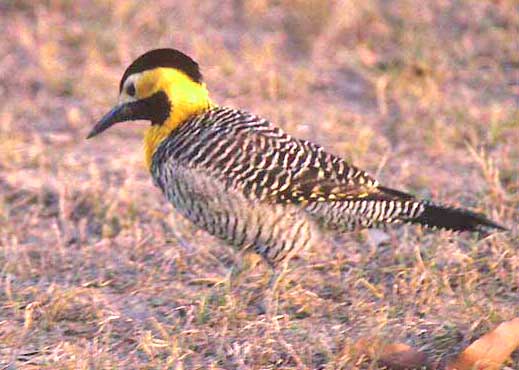

 Woodpeckers are simply impressive birds. I am pleased whenever I can
photograph one. I felt particularly lucky to photograph this pair of White-naped Woodpecker
in India (left). But these were not a "pair" in the traditional sense —
the yellow-crowned female was feeding the red-crowned bird. I think the
red-crowned one was her now full-grown fledgling. She had been working
a long time to get out the thick grub, and the shot was taken just
before she shoved the big grub down the youngster's gullet.
Woodpeckers are simply impressive birds. I am pleased whenever I can
photograph one. I felt particularly lucky to photograph this pair of White-naped Woodpecker
in India (left). But these were not a "pair" in the traditional sense —
the yellow-crowned female was feeding the red-crowned bird. I think the
red-crowned one was her now full-grown fledgling. She had been working
a long time to get out the thick grub, and the shot was taken just
before she shoved the big grub down the youngster's gullet. Woodpeckers
are a large family of similarly designed birds found in forested areas
around the globe. They have evolved to deal with chiseling wood,
including "shock-absorber" head musculature, extremely long tongues,
and stiff tail feathers helping them perch upright on trees (Winkler
& Christie 2002). Woodpeckers are often a "core species" of the
woodland avifauna [except in two major areas that don't have any
woodpeckers: Australasia and Madagascar]. I am very fond of the
woodpeckers that live in my yard on the Monterey Peninsula. This male Nuttall's Woodpecker
(right) was bringing food to nest hole just outside our bedroom window
in June 2002. We had left a tall stub of this dead Monterey pine when
we had to remove the top-heavy canopy for safety reasons, and the next
year we were rewarded with a pair of Nuttall's that fledged a
youngster. The tree stub would eventually crumble in high winter winds
a few years later, but "our" family of these attractive little
woodpeckers still frequents the neighborhood. Hairy Woodpecker Picoides villosus also nests occasionally in the yard, as do a small party of Acorn Woodpeckers.
Woodpeckers
are a large family of similarly designed birds found in forested areas
around the globe. They have evolved to deal with chiseling wood,
including "shock-absorber" head musculature, extremely long tongues,
and stiff tail feathers helping them perch upright on trees (Winkler
& Christie 2002). Woodpeckers are often a "core species" of the
woodland avifauna [except in two major areas that don't have any
woodpeckers: Australasia and Madagascar]. I am very fond of the
woodpeckers that live in my yard on the Monterey Peninsula. This male Nuttall's Woodpecker
(right) was bringing food to nest hole just outside our bedroom window
in June 2002. We had left a tall stub of this dead Monterey pine when
we had to remove the top-heavy canopy for safety reasons, and the next
year we were rewarded with a pair of Nuttall's that fledged a
youngster. The tree stub would eventually crumble in high winter winds
a few years later, but "our" family of these attractive little
woodpeckers still frequents the neighborhood. Hairy Woodpecker Picoides villosus also nests occasionally in the yard, as do a small party of Acorn Woodpeckers.  More
fine woodpeckers occur in the red fir/lodgepole pine forests of the
Sierra Nevada. There is almost nothing so pleasant on a lazy summer day
in the mountains as listening for the tapping of woodpeckers and
chasing each one down. The ultimate highlight is finding a rare Black-backed Woodpecker (left); this male was accompanied by a young fledgling.
More
fine woodpeckers occur in the red fir/lodgepole pine forests of the
Sierra Nevada. There is almost nothing so pleasant on a lazy summer day
in the mountains as listening for the tapping of woodpeckers and
chasing each one down. The ultimate highlight is finding a rare Black-backed Woodpecker (left); this male was accompanied by a young fledgling.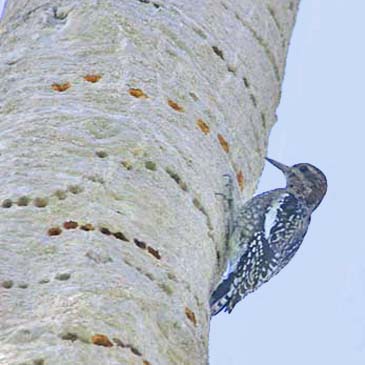

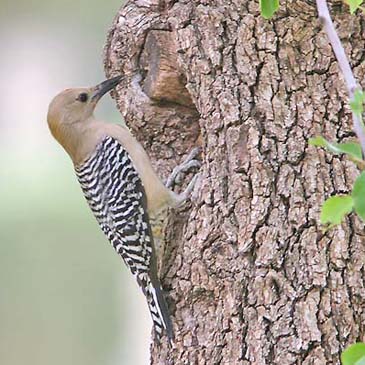
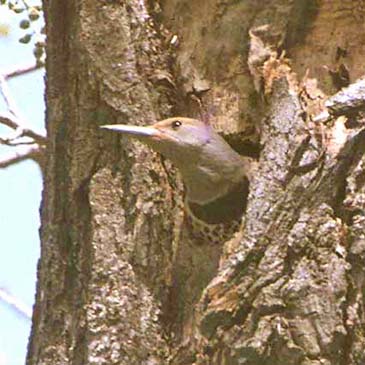
 With
over two hundred species around the world, there is tremendous
diversity among the woodpeckers. The two wrynecks of the Old World are
included within the family, and there are well over two dozen species
of tiny piculets in the world's tropics. There are also huge
forest-dominating species in the several genera, including the genera Dryocopus and Campephilus.
With
over two hundred species around the world, there is tremendous
diversity among the woodpeckers. The two wrynecks of the Old World are
included within the family, and there are well over two dozen species
of tiny piculets in the world's tropics. There are also huge
forest-dominating species in the several genera, including the genera Dryocopus and Campephilus.